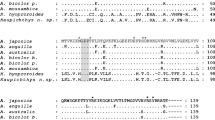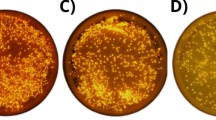Abstract
We discovered that some isolated eel skeletal muscle cells exhibited green fluorescence under a fluorescence stereomicroscope, and we successfully isolated a novel fluorescent protein from the eel muscle homogenate. The protein was a monomer with a molecular mass of 16.5–17 kDa and showed minor and major peaks at 280 and 493 nm, respectively, in the absorption spectrum. The molar extinction coefficient at 493 nm was 41,300 M−1 cm−1 and A280/A493 was 0.083. Excitation and emission spectra of the protein showed maxima at 493 and 527 nm, respectively. Heat treatment at 95°C for 10 min or 5% trichloroacetic acid treatment of the protein caused aggregation of the protein but did not release any fluorescent components such as FAD into the supernatant after centrifugation. Fluorescence of the protein remained after native PAGE, but not after SDS-PAGE. These results indicate that the purified fluorescent protein is not a flavoprotein, and that its fluorescent chromophore is a covalently bound one, such as green fluorescent protein (GFP) from jellyfish Aequoria victoria, but that its fluorescence requires its native conformation within the protein. Based on these results, we can conclude that the fluorescent protein obtained from eel skeletal muscle is a novel GFP-like protein.







Similar content being viewed by others
References
Babin PJ, Vernier J-M (1989) Plasma lipoproteins in fish. J Lipid Res 30:467–489
Hayashi S, Komatsu M (1999) Primary culture of eel hepatocytes—synthesis and secretion of lipoprotein. In: Doyle A, Griffiths JB, Newell DG (eds) Cell and tissue culture: laboratory procedures. Wiley, New York, pp 23A10–23A21
Kagawa A (1983) Shokuhin seibun-hyo. (Standard tables of food composition in Japan.) In: The Resource Investigation Committee, The Science and Technology Agency, Japan (ed) Shokuhin seibun-hyo. (Standard tables of food composition in Japan, 4th edn.) Kagawa Nutrition University Publishing Division, Tokyo, p 89 (in Japanese)
Job V, Marcone GL, Pilone MS, Pollegioni L (2002) Glycine oxidase from Bacillus subtilis. Characterization of a new flavoprotein. J Biol Chem 277:6985–6993
Simonetta MP, Pollegioni L, Casalin P, Curti B, Ronchi S (1989) Properties of d-amino-acid oxidase from Rhodotorula gracilis. Eur J Biochem 180:199–204
Wagner MA, Khanna P, Jorns MS (1999) Structure of the flavocoenzyme of two homologous amine oxidases: monomeric sarcosine oxidase and N-methyltryptophan oxidase. Biochemistry 38:5588–5595
Mihalik SJ, McGuinness M, Watkins PA (1991) Purification and characterization of peroxisomal l-pipecolic acid oxidase from monkey liver. J Biol Chem 266:4822–4830
Rosenblatt JD, Lunt AI, Parry DJ, Partridge TA (1995) Culturing satellite cells from living single muscle fiber explants. In Vitro Cell Dev Biol 31:773–779
Alam N, Nakamura K, Hayashi S (2004) Lipoprotein metabolism in a coculture system with eel skeletal muscle cells and hepatocytes. Fish Sci 70:326–335
Rosenfeld J, Capdevielle J, Guillemot JC, Ferrara P (1992) In-gel digestion of proteins for internal sequence analysis after one- or two-dimensional gel electrophoresis. Anal Biochem 203:173–179
Laemmli UK (1970) Cleavage of structural proteins during the assembly of the head of bacteriophage T4. Nature 227:680–685
Smith PK, Krohn RI, Hermanson GT, Mallia AK, Gartner FH, Provenzano MD, Fujimoto EK, Goeke NM, Olson BJ, Klenk DC (1985) Measurement of protein using bicinchoninic acid. Anal Biochem 150:76–85
Morise H, Shimomura O, Johnson FH, Winant J (1974) Intermolecular energy transfer in the bioluminescent system of Aequorea. Biochemistry 13:2656–2662
Tsien RY (1998) The green fluorescent protein. Annu Rev Biochem 67:509–544
Miyawaki A, Nagai T, Mizuno H (2003) Mechanisms of protein fluorophore formation and engineering. Curr Opin Chem Biol 7:557–562
Karasawa S, Araki T, Yamamoto-Hino M, Miyawaki A (2003) A green-emitting fluorescent protein from Galaxeidae coral and its monomeric version for use in fluorescent labeling. J Biol Chem 278:34167–34171
Karasawa S, Araki T, Nagai T, Mizuno H, Miyawaki A (2004) Cyan-emitting and orange-emitting fluorescent proteins as a doner/acceptor pair for fluorescence resonance energy transfer. Biochem J 381:307–312
Cubitt AB, Woollenweber LA, Heim R (1999) Understanding structure-function relationships in the Aequorea victoria green fluorescent protein. Meth Cell Biol 58:19–30
Bokman SH, Ward WW (1981) Renaturation of Aequorea green-fluorescent protein. Biochem Biophys Res Commun 101:1372–1380
Ward WW, Bokman SH (1982) Reversible denaturation of Aequorea green-fluorescent protein: physical separation and characterization of the renatured protein. Biochemistry 21:4535–4540
Shimomura O (1979) Structure of the chromophore of Aequorea green fluorescent protein. FEBS Lett 104:220–222
Cody CW, Prasher DC, Westler WM, Prendergast FG, Ward WW (1993) Chemical structure of hexapeptide chromophore of the Aequorea green-fluorescent protein. Biochemistry 32:1212–1218
Miyawaki A (2002) Green fluorescent protein-like proteins in reef Anthozoa animals. Cell Struct Funct 27:343–347
Lippincott-Schwartz J, Patterson GH (2003) Development and use of fluorescent protein markers in living cells. Science 300:87–91
Acknowledgments
We thank Dr. Kobayashi, Takara Bio Inc., for helpful suggestions. This work was supported in part by a Grant-in-Aid for Basic Research B (10460095) from the Ministry of Education, Culture, Sports, Science and Technology, Japan, and was also supported by Takara Bio Inc. We also thank Messrs Adachi and Honda for technical support.
Author information
Authors and Affiliations
Corresponding author
Rights and permissions
About this article
Cite this article
Hayashi, S., Toda, Y. A novel fluorescent protein purified from eel muscle. Fish Sci 75, 1461–1469 (2009). https://doi.org/10.1007/s12562-009-0176-z
Received:
Accepted:
Published:
Issue Date:
DOI: https://doi.org/10.1007/s12562-009-0176-z




